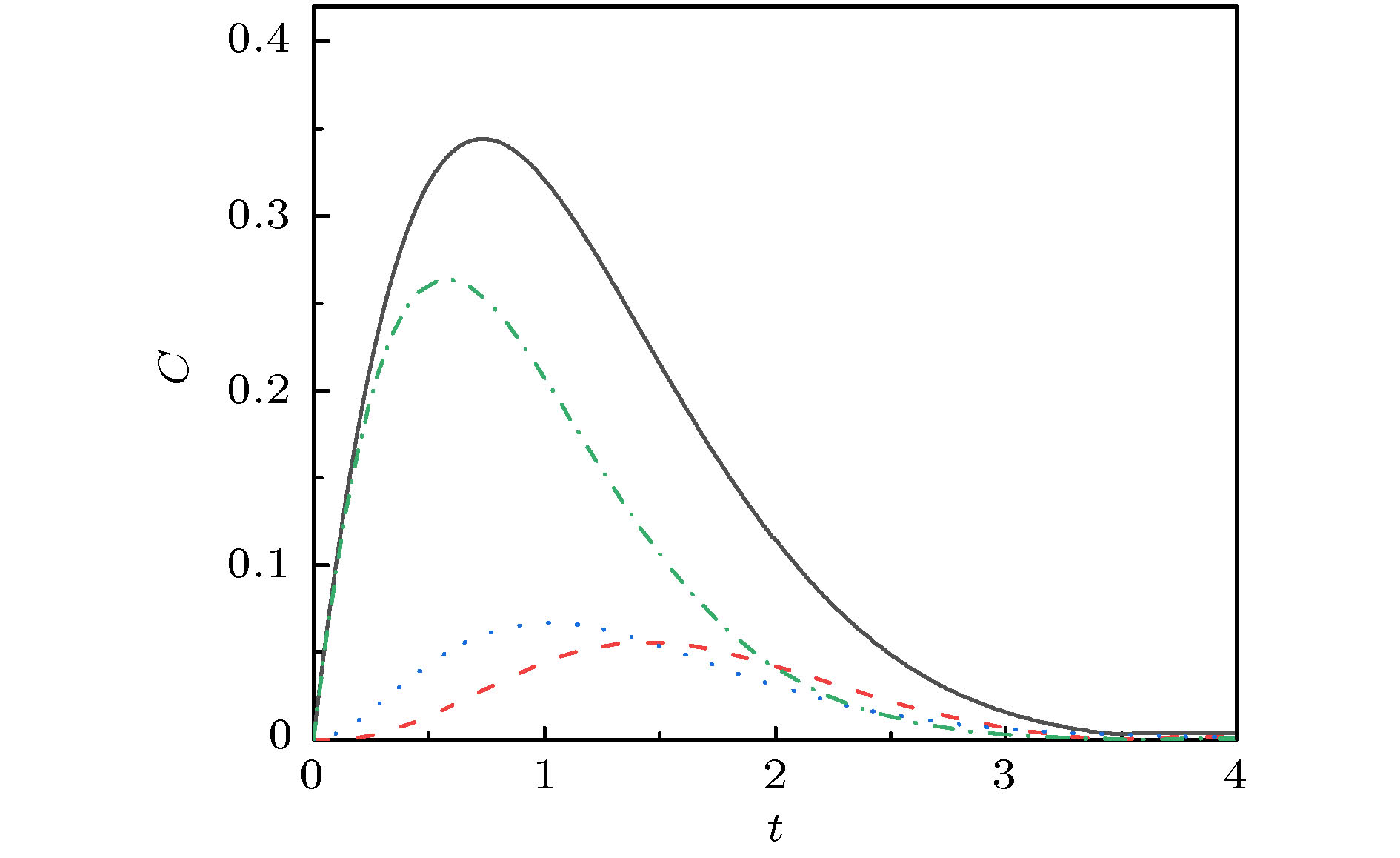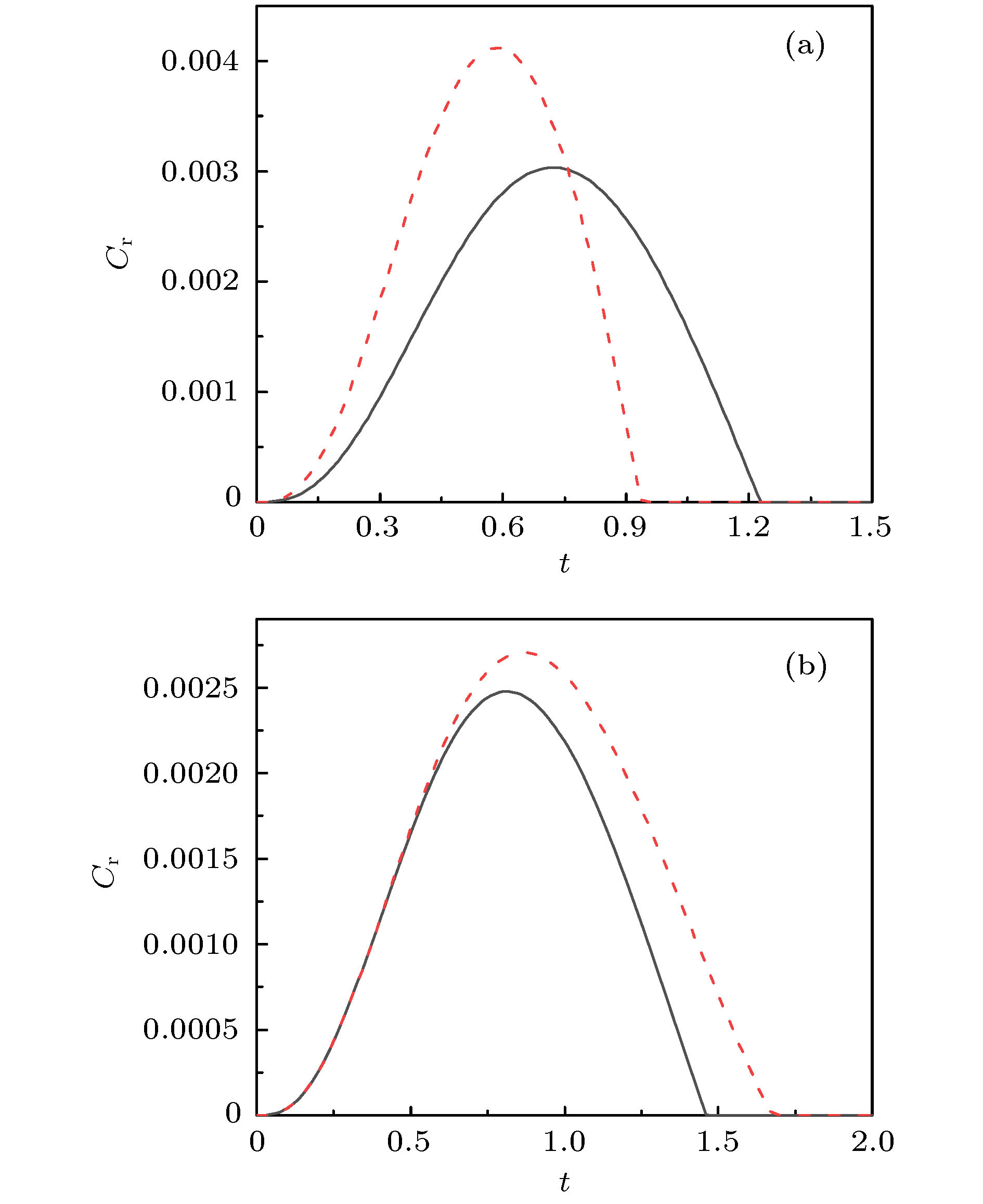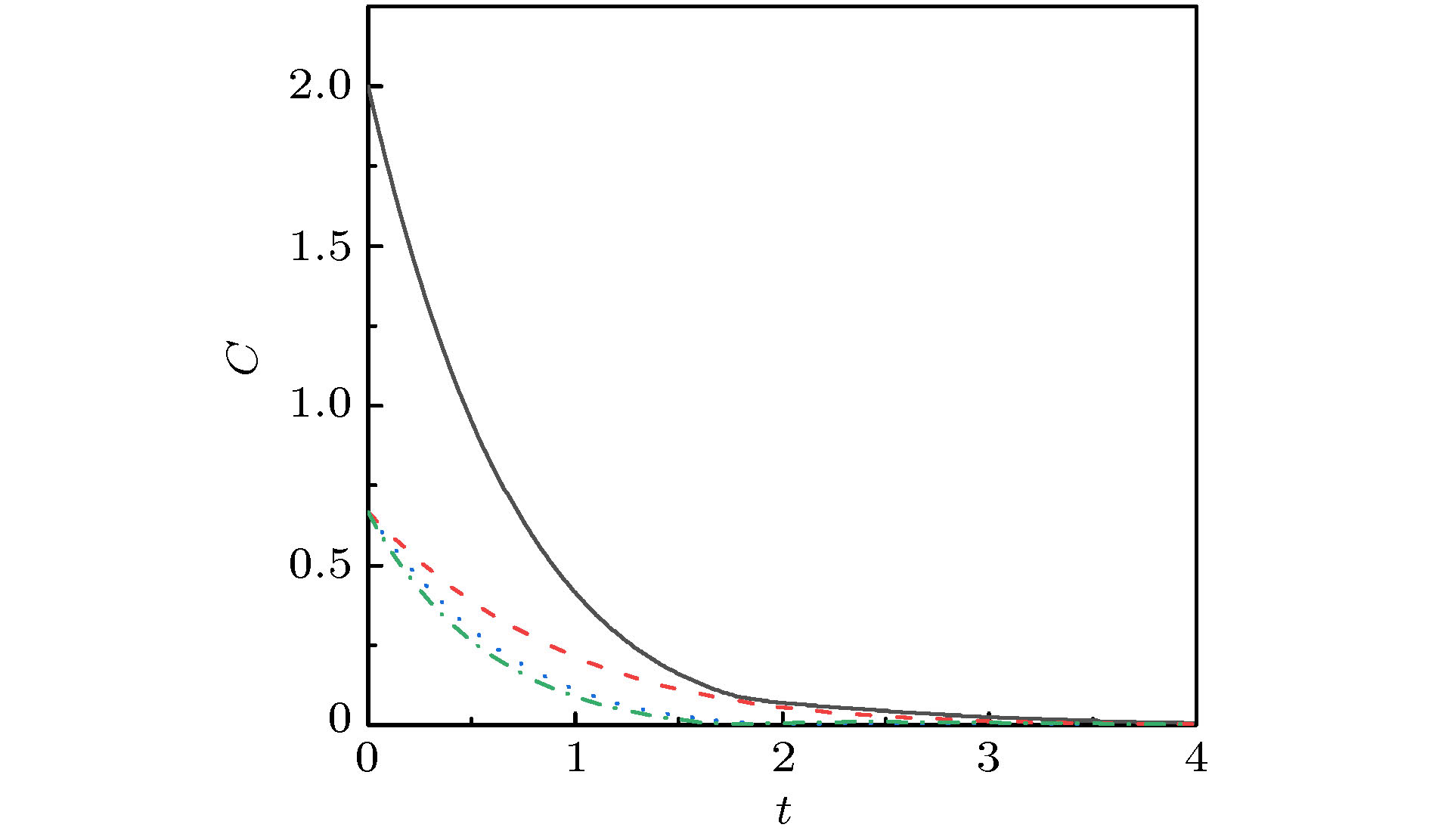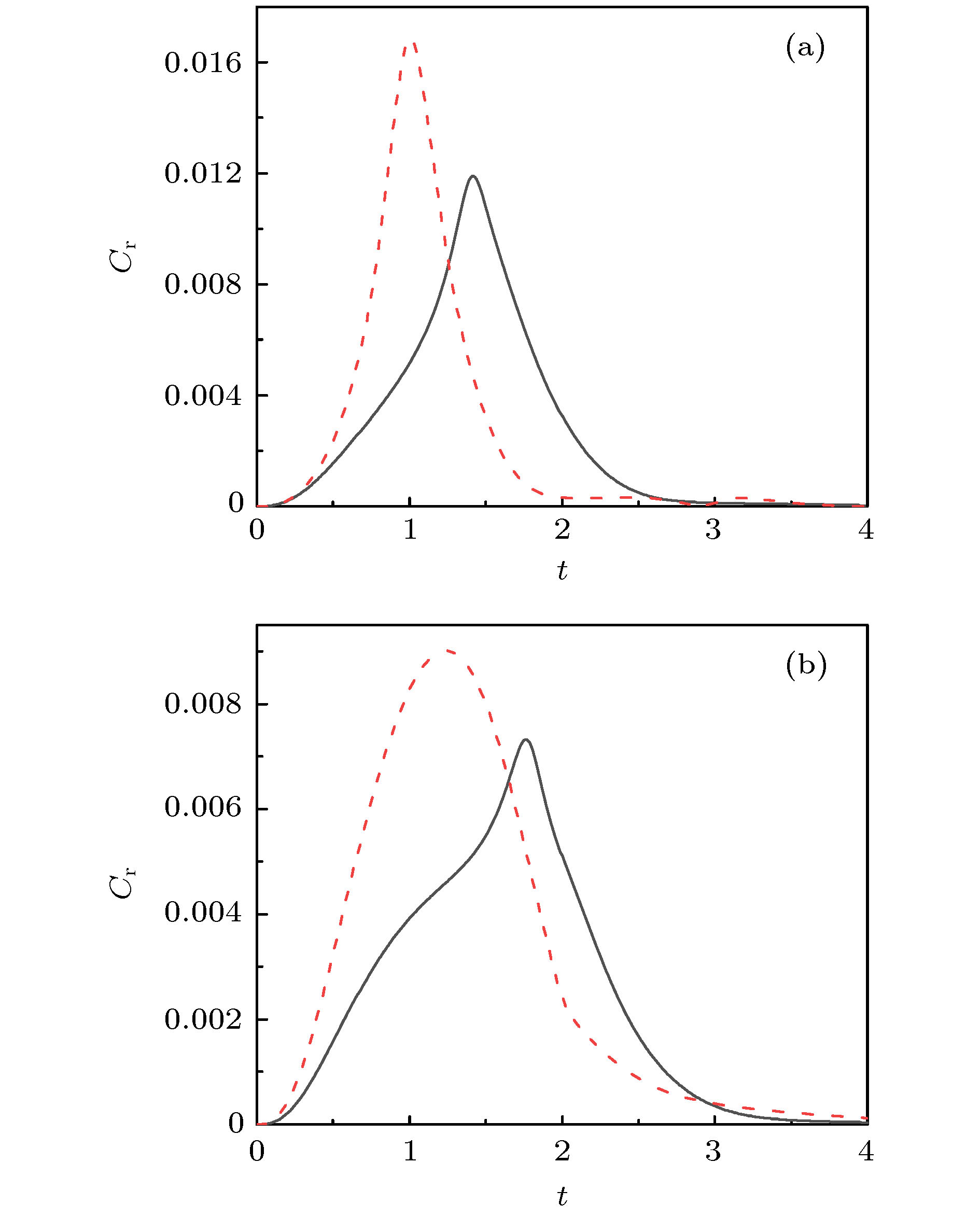-
本文以具有非对称性自旋相互作用的三体自旋系统为研究对象, 重点研究了三体量子相干含时演化规律. 采用精确量子对角化和基于量子主方程的数值模拟方法, 讨论了三体量子系统中多种量子相干组分及其退相干. 研究发现, 量子相干组分的含时演化与整个系统的初态量子特性紧密相关. 当初态为可分离纯态时, 在较短时间内, 非对称相互作用有利于增加多体量子相干度. 这些量子相干度因受噪声影响而逐渐衰减. 当初态为类Werner态时, 量子相干度的分布满足加和性, 即三体量子相干度等于所有两体量子相干度之和. 自旋之间非对称相互作用和环境噪声都会引起三体量子相干度大于所有两体量子相干度之和. 这些结论有助于多体量子资源的制备.The time evolution of multipartite quantum coherence is studied in a three-body spin system with an asymmetric interaction. The l1 norm measurement is used to estimate the degree of quantum coherence in the spin system. The decoherence of all components of quantum coherence in the three-body spin system is analyzed by the exact diagnolization and numerical method based on quantum master equation. The environmental noise induced by the spontaneous decay can be simulated by the quantum amplitude damping model. It is found that the time evolution of quantum coherence component is closely related to the quantum property of the whole initial state. When the initial state is a separable pure one, the asymmetric interactions can conduce to the enhancement of the degree of multipartite quantum coherence in a short time interval. Under the influence of quantum noise, the degree of quantum coherence decreases gradually. We pay much attention to the spatial distribution of the degree of quantum coherence in a many-body system. The additivity relationship of bipartite component and tripartite coherence can exist if the initial state is chosen to be a Werner-like state. This kind of the coherence additivity between all bipartite components and global coherence can be extended to an arbitrary N-body Werner-like state. But this additivity relationship depends on the l1 norm coherence measurement. Owing to the asymmetric interaction and noise, the degree of tripartite quantum coherence is more than the sum of all degrees of bipartite quantum coherence. The difference between the degree of tripartite coherence and the sum of all degrees of bipartite coherence is increased in a short time interval. The environmental noise can also suppress the difference in the coherence degree. The degree of the nearest neighboring bipartite coherence decreases more quickly than those of other bipartite coherences. The asymmetric interaction gives rise to the improvement in the degree of bipartite coherence and tripartite coherence. The coherence of the next-nearest neighboring two systems can be robust against the environmental noise. These results are helpful in preparing the multipartite quantum resources. We can utilize the system of coupled micro-cavities to realize the quantum spin system with controllable asymmetric interaction. In this way, the global coherence and bipartite coherence can be manipulated effectively by the quantum electromagnetic technology.
-
Keywords:
- multipartite quantum coherence /
- asymmetric spin systems /
- quantum decoherence /
- quantum master equation
[1] 吕为民 2019 博士学位论文 (北京: 中国科学技术大学)
Lv W M 2019 Ph. D. Dissertation (Beijing: University of Science and Technology of China) (in Chinese)
[2] Barney R D, Huele J F S V 2019 Phys. Scr. 94 105105
 Google Scholar
Google Scholar
[3] Ding Z Y, Yang H, Yuan H, Wang D, Yang J, Ye L 2019 Phys. Rev. A 100 022308
 Google Scholar
Google Scholar
[4] Kouzakov K A, Chotorlishvili L, Wtzel J, Berakdar J, Ernst A 2019 Phys. Rev. A 100 022311
 Google Scholar
Google Scholar
[5] Guo W J, Wei L F 2017 Chin. Phys. B 26 010303
 Google Scholar
Google Scholar
[6] Liu Z, Qiu L, Pan F 2017 Quantum Inf. Process. 16 109
 Google Scholar
Google Scholar
[7] Khmelinskii I, Makarov V I 2020 Chem. Phys. 532 110671
 Google Scholar
Google Scholar
[8] Afsaneh E, Bagheri H M, Jafari M 2018 J. Phys. B: At. Mol. Opt. Phys. 51 145502
 Google Scholar
Google Scholar
[9] 高明 2011 博士学位论文 (湖南: 国防科学技术大学)
Gao M 2011 Ph. D. Dissertation (Hunan: National University of Defense Technology) (in Chinese)
[10] Chuchem M, Cohen D 2010 Physica E 42 555
 Google Scholar
Google Scholar
[11] Trushechkin A S 2019 Math Notes 106 986
 Google Scholar
Google Scholar
[12] Rodriguez-Rosario C A, Frauenheim T, Aspuru-Guzik A 2019 Open Syst. Inf. Dyn. 26 1950022
 Google Scholar
Google Scholar
[13] Balazadenh L, Najarbashi G, Tavana A 2018 Sci. Rep. 8 17789
 Google Scholar
Google Scholar
[14] Escalera-Moreno L, Gaita-Ariño A, Coronado E 2019 Phys. Rev. B 100 064405
 Google Scholar
Google Scholar
[15] Lin C W, Sels D, Wang Y B 2020 Phys. Rev. A 101 022320
 Google Scholar
Google Scholar
[16] Baumgratz T, Cramer M, Plenio M B 2014 Phys. Rev. Lett. 113 140401
 Google Scholar
Google Scholar
[17] Zhao M J, Ma T, Quan Q, Fan H, Pereira R 2019 Phys. Rev. A 100 012315
 Google Scholar
Google Scholar
[18] Hu M L, Fan H 2018 Phys. Rev. A 98 022312
 Google Scholar
Google Scholar
[19] Gao D M, Lv T H 2019 Int. J. Theor. Phys. 58 1195
 Google Scholar
Google Scholar
[20] Sargolzahi I, Mirafzali S Y 2019 Phys. Rev. A 100 042121
 Google Scholar
Google Scholar
[21] 张志君 2017 硕士学位论文 (南京: 南京邮电大学)
Zhang Z J 2017 M. S. Thesis (Nanjing: Nanjing University of Posts and Telecommunications) (in Chinese)
[22] 范洪义 2014 63 020302
 Google Scholar
Google Scholar
Fan H Y 2014 Acta Phys. Sin. 63 020302
 Google Scholar
Google Scholar
[23] 田聪, 鹿翔, 张英杰, 夏云杰 2019 68 150301
 Google Scholar
Google Scholar
Tian C, Lu X, Zhang Y J, Xia Y J 2019 Acta Phys. Sin. 68 150301
 Google Scholar
Google Scholar
[24] Yuan Z G, Zhang P, Li S S, Jian J 2016 Ann. Phys. 365 223
 Google Scholar
Google Scholar
[25] Karpat G, Cakmak B, Fanchini F F 2014 Phys. Rev. B 90 104431
 Google Scholar
Google Scholar
[26] Malvezzi A L, Karpat G, Cakmak B, Fanchini F F, Debarba T, Vianna R O 2016 Phys. Rev. B 93 184428
 Google Scholar
Google Scholar
[27] Korenic A, Perovic S, Cirkovic M M, Miquel P A 2020 Prog. Biophys. Mol. Biol. 150 1
 Google Scholar
Google Scholar
[28] Xu P, Hu Y H, Hou X W 2018 Physica A 491 282
 Google Scholar
Google Scholar
[29] Peng H P, Fang M F, Yu M, Zou H M 2018 Int. J. Theor. Phys. 57 1872
 Google Scholar
Google Scholar
[30] Ming F, Wang D, Shi W N, Huang A J, Du M M, Sun W Y, Ye L 2018 Quantum Inf. Process. 17 267
 Google Scholar
Google Scholar
[31] Xie Y X, Gao Y Y 2019 Laser Phys. Lett. 16 045202
 Google Scholar
Google Scholar
[32] Radhakrishnan C, Ermakov I, Byrnes T 2017 Phys. Rev. A 96 012341
 Google Scholar
Google Scholar
[33] Hui N J, Xu Y Y, Wang J, Zhang Y, Hu Z D 2017 Physica B 510 7
 Google Scholar
Google Scholar
[34] Feldman K E 2006 J. Phys. A: Math. Gen. 39 1039
 Google Scholar
Google Scholar
[35] Levitov L S, Rashba E I 2001 Phys. Rev. B 67 115324
[36] Dzyaloshinskii I 1958 Phys. Chem. Solids 4 241
 Google Scholar
Google Scholar
[37] Moriya T 1960 Phys. Rev. 120 91
 Google Scholar
Google Scholar
[38] De Raedt H, Miyashita S, Michielsen K and Machida M 2004 Phys. Rev. B 70 064401
 Google Scholar
Google Scholar
[39] Hartmann M J, Brand O F G S L, Plenio M B 2007 Phys. Rev. Lett. 99 160501
 Google Scholar
Google Scholar
[40] Chen Z X, Zhou Z W, Zhou X, Zhou X F, Guo G C 2010 Phys. Rev. A 81 022303
 Google Scholar
Google Scholar
[41] Yu T, Eberly J H 2004 Phys. Rev. Lett. 93 140404
 Google Scholar
Google Scholar
-
图 1 当初态为
$ \left| {001} \right\rangle $ 时, 量子相干组分演化, 参量选取为$ D = 0.2, $ $ \gamma = 0.2, $ $ \varGamma = 0.5, $ $ n = 0.2$ , 黑色实线为$ {C_{123}}$ , 红色虚线和绿色点划线分别为$ {C_{12}}, {C_{13}}$ , 蓝色点线为$ {C_{23}}$ Fig. 1. The dynamics of all fractions of quantum coherence for the initial state
$ \left| {001} \right\rangle $ . The parameters are chosen to be$ D = 0.2, $ $ \gamma = 0.2, $ $ \varGamma = 0.5, $ $ n = 0.2$ . The black solid line denotes$ {C_{123}}$ , the red dashed and green dot-dashed line are$ {C_{12}}, {C_{13}}$ respectively, and the blue dotted line represents$ {C_{23}}$ .图 2 当初态为
$ \left| {001} \right\rangle $ 时, 量子相干组分差值的演化, 参量选取为$ \varGamma = 0.5, $ $ n = 0.2$ (a) 当$ \gamma = 0.2$ 时, 黑色实线对应参数$ D = 0.3, $ 红色虚线对应$ D = 0.5;$ (b)当$ D = 0.2$ 时, 黑色实线对应参数$ \gamma = 0.3, $ 红色虚线对应$ \gamma = 0.7$ Fig. 2. The dynamics of the difference of quantum coherence for the initial state
$ \left| {001} \right\rangle $ . The parameters are chosen to be$ \varGamma = 0.5, $ $ n = 0.2$ : (a) When$ \gamma = 0.2$ , the black solid line denotes$ D = 0.3$ the red dashed line is$ D = 0.5;$ (b) When$ D = 0.2$ , the black solid line denotes$ \gamma = 0.3, $ the red dashed line is$ \gamma = 0.7$ .图 3 当初态为W态时, 量子相干组分演化, 参量
$ D = 0.2, $ $ \gamma = 0.2, $ $ \varGamma = 0.5, $ $ n = 0.2$ , 黑色实线为$ {C_{123}}$ , 红色虚线和绿色点划线分别为$ {C_{12}}, {C_{13}}$ , 蓝色点线为$ {C_{23}}$ Fig. 3. The dynamics of all fractions of quantum coherence for the initial W state. The parameters are chosen to be
$ D = 0.2, $ $ \gamma = 0.2, $ $ \varGamma = 0.5, $ $ n = 0.2$ . The black solid line denotes$ {C_{123}}$ , the red dashed and green dot-dashed line are$ {C_{12}}, {C_{13}}$ respectively, and the blue dotted line represents$ {C_{23}}$ .图 4 当初态为W态时, 量子相干组分差值的演化, 参量选取为
$ \varGamma = 0.5, $ $ n = 0.2$ (a) 当$ \gamma = 0.2$ 时, 黑色实线对应参数$ D = 0.3, $ 红色虚线对应$ D = 0.5;$ (b)当$ D = 0.2$ 时, 黑色实线对应参数$ \gamma = 0.3, $ 红色虚线对应$ \gamma = 0.7$ Fig. 4. The dynamics of the difference of quantum coherence for the initial W state. The parameters are chosen to be
$ \varGamma = 0.5, $ $ n = 0.2$ ; (a) When$ \gamma = 0.2$ , the black solid line denotes$ D = 0.3$ the red dashed line is$ D = 0.5;$ (b) When$ D = 0.2$ , the black solid line denotes$ \gamma = 0.3, $ the red dashed line is$ \gamma = 0.7$ . -
[1] 吕为民 2019 博士学位论文 (北京: 中国科学技术大学)
Lv W M 2019 Ph. D. Dissertation (Beijing: University of Science and Technology of China) (in Chinese)
[2] Barney R D, Huele J F S V 2019 Phys. Scr. 94 105105
 Google Scholar
Google Scholar
[3] Ding Z Y, Yang H, Yuan H, Wang D, Yang J, Ye L 2019 Phys. Rev. A 100 022308
 Google Scholar
Google Scholar
[4] Kouzakov K A, Chotorlishvili L, Wtzel J, Berakdar J, Ernst A 2019 Phys. Rev. A 100 022311
 Google Scholar
Google Scholar
[5] Guo W J, Wei L F 2017 Chin. Phys. B 26 010303
 Google Scholar
Google Scholar
[6] Liu Z, Qiu L, Pan F 2017 Quantum Inf. Process. 16 109
 Google Scholar
Google Scholar
[7] Khmelinskii I, Makarov V I 2020 Chem. Phys. 532 110671
 Google Scholar
Google Scholar
[8] Afsaneh E, Bagheri H M, Jafari M 2018 J. Phys. B: At. Mol. Opt. Phys. 51 145502
 Google Scholar
Google Scholar
[9] 高明 2011 博士学位论文 (湖南: 国防科学技术大学)
Gao M 2011 Ph. D. Dissertation (Hunan: National University of Defense Technology) (in Chinese)
[10] Chuchem M, Cohen D 2010 Physica E 42 555
 Google Scholar
Google Scholar
[11] Trushechkin A S 2019 Math Notes 106 986
 Google Scholar
Google Scholar
[12] Rodriguez-Rosario C A, Frauenheim T, Aspuru-Guzik A 2019 Open Syst. Inf. Dyn. 26 1950022
 Google Scholar
Google Scholar
[13] Balazadenh L, Najarbashi G, Tavana A 2018 Sci. Rep. 8 17789
 Google Scholar
Google Scholar
[14] Escalera-Moreno L, Gaita-Ariño A, Coronado E 2019 Phys. Rev. B 100 064405
 Google Scholar
Google Scholar
[15] Lin C W, Sels D, Wang Y B 2020 Phys. Rev. A 101 022320
 Google Scholar
Google Scholar
[16] Baumgratz T, Cramer M, Plenio M B 2014 Phys. Rev. Lett. 113 140401
 Google Scholar
Google Scholar
[17] Zhao M J, Ma T, Quan Q, Fan H, Pereira R 2019 Phys. Rev. A 100 012315
 Google Scholar
Google Scholar
[18] Hu M L, Fan H 2018 Phys. Rev. A 98 022312
 Google Scholar
Google Scholar
[19] Gao D M, Lv T H 2019 Int. J. Theor. Phys. 58 1195
 Google Scholar
Google Scholar
[20] Sargolzahi I, Mirafzali S Y 2019 Phys. Rev. A 100 042121
 Google Scholar
Google Scholar
[21] 张志君 2017 硕士学位论文 (南京: 南京邮电大学)
Zhang Z J 2017 M. S. Thesis (Nanjing: Nanjing University of Posts and Telecommunications) (in Chinese)
[22] 范洪义 2014 63 020302
 Google Scholar
Google Scholar
Fan H Y 2014 Acta Phys. Sin. 63 020302
 Google Scholar
Google Scholar
[23] 田聪, 鹿翔, 张英杰, 夏云杰 2019 68 150301
 Google Scholar
Google Scholar
Tian C, Lu X, Zhang Y J, Xia Y J 2019 Acta Phys. Sin. 68 150301
 Google Scholar
Google Scholar
[24] Yuan Z G, Zhang P, Li S S, Jian J 2016 Ann. Phys. 365 223
 Google Scholar
Google Scholar
[25] Karpat G, Cakmak B, Fanchini F F 2014 Phys. Rev. B 90 104431
 Google Scholar
Google Scholar
[26] Malvezzi A L, Karpat G, Cakmak B, Fanchini F F, Debarba T, Vianna R O 2016 Phys. Rev. B 93 184428
 Google Scholar
Google Scholar
[27] Korenic A, Perovic S, Cirkovic M M, Miquel P A 2020 Prog. Biophys. Mol. Biol. 150 1
 Google Scholar
Google Scholar
[28] Xu P, Hu Y H, Hou X W 2018 Physica A 491 282
 Google Scholar
Google Scholar
[29] Peng H P, Fang M F, Yu M, Zou H M 2018 Int. J. Theor. Phys. 57 1872
 Google Scholar
Google Scholar
[30] Ming F, Wang D, Shi W N, Huang A J, Du M M, Sun W Y, Ye L 2018 Quantum Inf. Process. 17 267
 Google Scholar
Google Scholar
[31] Xie Y X, Gao Y Y 2019 Laser Phys. Lett. 16 045202
 Google Scholar
Google Scholar
[32] Radhakrishnan C, Ermakov I, Byrnes T 2017 Phys. Rev. A 96 012341
 Google Scholar
Google Scholar
[33] Hui N J, Xu Y Y, Wang J, Zhang Y, Hu Z D 2017 Physica B 510 7
 Google Scholar
Google Scholar
[34] Feldman K E 2006 J. Phys. A: Math. Gen. 39 1039
 Google Scholar
Google Scholar
[35] Levitov L S, Rashba E I 2001 Phys. Rev. B 67 115324
[36] Dzyaloshinskii I 1958 Phys. Chem. Solids 4 241
 Google Scholar
Google Scholar
[37] Moriya T 1960 Phys. Rev. 120 91
 Google Scholar
Google Scholar
[38] De Raedt H, Miyashita S, Michielsen K and Machida M 2004 Phys. Rev. B 70 064401
 Google Scholar
Google Scholar
[39] Hartmann M J, Brand O F G S L, Plenio M B 2007 Phys. Rev. Lett. 99 160501
 Google Scholar
Google Scholar
[40] Chen Z X, Zhou Z W, Zhou X, Zhou X F, Guo G C 2010 Phys. Rev. A 81 022303
 Google Scholar
Google Scholar
[41] Yu T, Eberly J H 2004 Phys. Rev. Lett. 93 140404
 Google Scholar
Google Scholar
计量
- 文章访问数: 6615
- PDF下载量: 95
- 被引次数: 0






























 下载:
下载:



















































